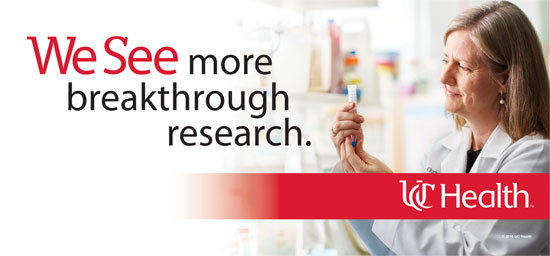
Turning discoveries into the most safest, innovative treatments available
Traditionally, there’s been a long lag time before scientific discoveries could actually be turned into new medical therapies that could help patients. One reason for this is that in the past, scientists often spent most of their time in the lab, and clinicians were busy treating patients. The two seldom crossed paths. But today, there is a new type of researcher—known as a translational researcher—who works side by side with clinicians to get an even better understanding of the complex cardiovascular system, helping them gain the insight needed to more quickly turn discoveries into new therapies for people with or at risk for heart or vascular disease. At the UC Heart, Lung & Vascular Institute, we drive toward breakthroughs in treating heart and cardiovascular disease through three main methods of research:
- Basic research
- Translational research
- Clinical research
Bench to bedside approach and clear research goals lead to improved patient care
The UC Heart, Lung & Vascular Institute embraces science-driven patient care. This bench-to-bedside approach is fundamental in the research discoveries that lead to innovative therapies for patients with cardiovascular disease. The research goals of the UC Heart, Lung & Vascular Institute include:
- Strengthening the bridges between basic and clinical cardiovascular research to provide patients with the best possible care
- Supporting cutting-edge research that leads to the discovery of novel technologies and therapeutics
- Expanding current research into promising new areas
- Translating and commercializing discoveries into products that can be used by clinicians to provide care to patients
- Recruiting prominent faculty to enhance research strengths
At the leading-edge of cardiovascular research
The UC Heart, Lung & Vascular Institute is at the cutting-edge of basic research in the region and the nation, attracting large amounts of NIH funding, forming spin-off companies and translating its findings to better patient care. In addition, the UC Heart, Lung & Vascular Institute is the only place in the city doing research in heart failure, arrhythmias, cell death, stem cells and other areas with the aim to translate the basic findings to the clinic. We were the first in the nation to show that:
- Sarcoplasmic reticulum calcium cycling and contractility is linked to cell death.
- There is a multimeric complex of several gene products that mediates a cross-talk between heart function and cell death or survival.
- There human mutations in calcium cycling genes linked to heart failure or arrhythmias and these can be used as prognostic or diagnostic markers in heart failure progression or arrhythmia development.
- Specific genes may serve as excellent new therapeutic targets for heart failure
- Peripheral nociceptor stimulation can improve muscle survival after heart attack
- The function of a new calcium channel, TRPV2, in normal and diseased hearts
